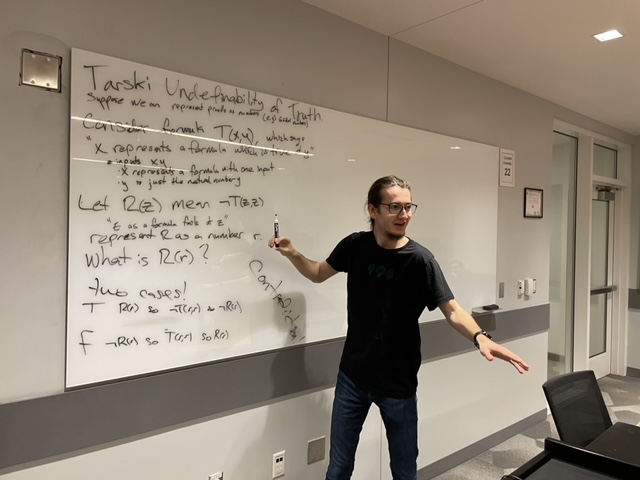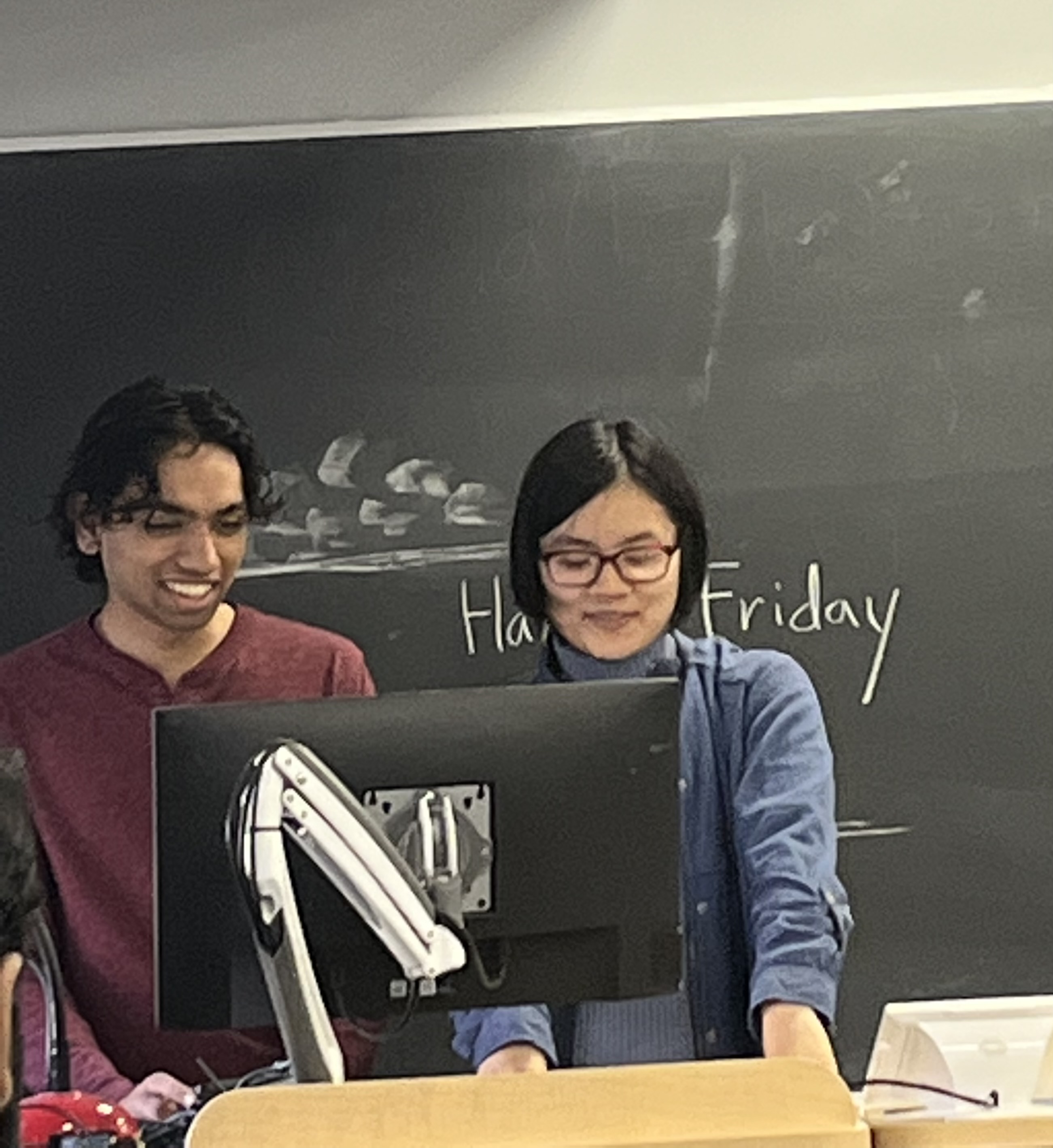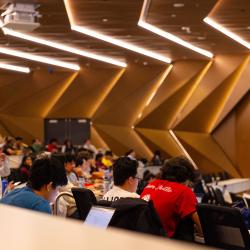Beyond the Numbers: Learning the Art and Philosophy of Mathematics
In UMD’s unique Student Initiated Courses, student instructors can share their passions with their peers while developing invaluable leadership and teaching skills.
Every semester, the University of Maryland offers students the opportunity to lead and attend special classes called Student Initiated Courses (STICs). Through the program, students design, develop and teach their own courses under the guidance of faculty advisors.
This fall, the UMD Department of Mathematics offered two exciting STICs: one on the philosophical foundations of math and the other on mathematics and art.
The Philosophical Foundations of Math: Ripping Logic at the Seams
When UMD mathematics sophomore Samuel Lidz was a young child, he already knew that he loved math and all its mysteries. As he grew up, he found traces of math in the most mundane details of his life.
“I’d stare at the ceiling for ages,” Lidz recalled with a laugh. “I would look at the ceiling tiles above me for a really long time and just count them. I was trying to figure out the multiplication table.”

Lidz carried this passion and talent with him to high school, where he took a special math class that explored both the logic and history behind mathematical concepts. It was like no other math class he’d ever taken, and the memorable experience instilled a desire in him to someday teach a class of his own.
Ezra Aylaian, another UMD math major, shares a similar story. Aylaian pursued their love for math throughout their academic career, even writing all their English 101 papers on the history of mathematics when given free rein over essay topics. After performing extensive research for the papers, Aylaian realized that the content could serve as lesson materials for a hypothetical math or philosophy class.
By chance, the two math majors met in a study lounge located in Kirwan Hall and struck up a conversation about Aylaian’s math research. From there, a magical partnership was born.
“Ever since I first heard about STICs pretty early on, maybe before even coming to UMD, I knew that I wanted to teach one,” Aylaian said. “So, I really jumped at the chance to teach this class, especially when Sam showed up in front of me with that same interest.”
The two student-instructors actively shaped MATH 299R to be a unique experience for anyone accustomed to more conventional math courses. Their curriculum spans thousands of years of mathematics, beginning with foundational philosophical ideas from Platonism and ending with more modern 21st-century perspectives. Driven by their desire to foster curiosity and give context to the theorems and rules taught throughout their academic careers, Lidz and Aylaian decided to create a more interactive and fluid learning environment for their students.
“Most of the time, unfortunately, we just get told the math,” Aylaian explained. “We don’t really explain how that math came to be, who came up with that math, what their viewpoints were, what makes the math controversial—for example, ancient Greeks hated the concept of infinity, of a never-ending number. Negative numbers were controversial when they were introduced. People had an uproar when imaginary numbers came up, too.”
“I believe that teaching students to accept a certain way of doing math without mentioning the long-standing and unfinished philosophical debate behind it is a disservice.”
As a result, the classes were designed to be just as dynamic as the course content.
“On some days, it’s a math class. On others, it’s a history or philosophy class,” Lidz said. “We still do proofs, but it’s certainly a very different style of doing math than most people are used to. We’re trying to mix it all up so that you can’t have one without the other.”
Like many other instructors, Lidz and Aylaian occasionally assign reading homework to their students. But these readings are not typical excerpts from textbooks. They’re fairly “bold and provocative, even controversial” math perspectives, Lidz and Aylaian explained.
“I can’t imagine that a general layperson would ever think that math could be controversial or that people can get into actual fights about certain math topics,” Aylaian laughed. “But there are figures out there, like Errett Bishop, who do make these assertions about alternate math systems that align more with philosophical views than what we generally regard as math.”
True to their words, Lidz and Aylaian avoid simply asking a question and giving an answer. Instead, they want their students to develop their own opinions about the topics that the class covers. Aylaian hopes that their class “brings out the soul of mathematics” and inspires people from all backgrounds to form their own unique takes on a subject often thought of as canonized.
“The philosophy that we have about math influences the mathematics that we do. And in turn, the math that we do affects our philosophy of math. So, there’s this dual cycle going on here; ideology can shape what a mathematician or scientist views as acceptable reality, and it’s really important for people to realize this,” Aylaian said. “These are ideas for everyone, not just math majors.”
MATH 299 R was facilitated by Samuel Lidz and Ezra Aylaian. Their faculty advisor was Mathematics Senior Lecturer Terence Long.
Mathematics and Art
To most, math functions may not seem particularly pleasing to the eye.
But for UMD mathematics majors Karthik Sellakumaran Latha and Rae Wu, there is incredible beauty to be found in numbers.
Sellakumaran Latha’s interest in the relationship between art and math first sparked during his freshman year when he attended a conference featuring a keynote speaker on illusions in math.
“The talk mentioned sona diagrams, which are based on a traditional storytelling method in certain parts of Africa,” Sellakumaran Latha said. “They told stories by drawing lines in the sand, often in really complicated interwoven patterns and shapes. Someone did the math behind those lines and it really got me thinking about how maybe there were lots of connections like this. And I remembered the idea of the golden ratio, and how that particular ratio can be found everywhere in art. It was definitely kind of spooky, but I wanted to learn more.”
For Wu, the relationship between math and art wasn’t just a theory they believed in but a practice that they actively applied to their own work—both professionally and personally. As an artist double majoring in math and computer science, Wu often blends their art skills with their more technical education. From product design to graphic design, Wu finds opportunities to show that the patterns and rules found in math also appear in many forms of art.
“Growing up, I always wanted to go to art school and become an artist, so my love of art definitely came first,” Wu said. “I was really into video editing, animation and video games, so I started learning about procedural regeneration, which has to do with changing terrain and space in games. I realized that there was this intrinsic connection between math and art. And so, I figured that I had to learn this technical ability in order to get the art that I wanted to create.”
Sellakumaran Latha and Wu wondered how they could pursue this seemingly niche interest at UMD when there wasn’t a class that was exclusively dedicated to explaining the mathematical theory behind art while also allowing the creation of art. But they soon realized that the STICs program could help them change that.

Sellakumaran Latha first learned about the STICs program when he was applying to the university three years ago. Now a junior, he remembers the initial curiosity he had about STICs and the freedom that students had to choose to either teach or attend. Similarly, in their freshman year, Wu recalled that their friends took a computer science STIC that provided guidance on technical interviews for undergraduate students looking to impress employers.
“It just seemed so cool that the UMD admins would let students run their own course,” Sellakumaran Latha said. “It was such a unique concept to me, especially because STICs aren’t as restrictive when it comes to content. The program actually helped tip the scales in UMD’s favor when I was choosing which university to attend.”
For both Sellakumaran Latha and Wu, giving their students a different outlook on math while fostering a space for creativity was extremely important. To do so, they divided the class into short units featuring types of art that have mathematical properties, ranging from perspective and proportion in painting to geometry in knitting and origami. The lessons were deliberately split so that students could learn the functions and equations behind a type of art before having the chance to create their own distinct pieces.
“It’s still a math class, of course,” Wu said. “But we wanted to give everyone the time and freedom to let their creativity out, and we’ve gotten really interesting work in return. We’ve even had a presentation on the fine art of juggling as an example of applied math, which just shows that math can be present in so many different types of art.”
According to Sellakumaran Latha, the STIC was a learning experience for everyone involved. He and Wu were teachers, but they also learned from their students and enhanced their own skills as leaders and communicators.
“There are some main takeaways that we want everyone—including the two of us— to carry on as the semester closes,” Sellakumaran Latha added. “First, the idea that math can help people create or enhance art. The other idea is the opposite—understanding how art can help people learn and communicate math. We’d like for everyone to see how much the two fields have in common, including the need for creativity, and how we can combine the two in our lives.”
Math 299 W was facilitated by Karthik Sellakumaran Latha and Rae Wu. Their faculty advisor was Mathematics Professor Niranjan Ramachandran.







